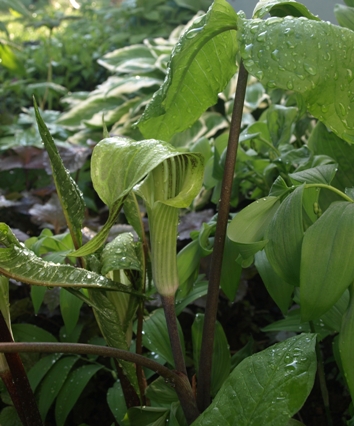Contents:
Common Names | Parts Usually Used | Plant(s) & Culture | Where Found | Medicinal Properties | Biochemical Information
Legends, Myths and Stories | Uses | Warning | Bibliography
Scientific Names

- Arisaema triphyllum L.
- Arisaema thunbergil
- A. maculatum
- Araceae
- Arum family
Common Names
- Bog-onion
- Dragonroot
- Hu-chang (Chinese name)
- Jack-in-the-pulpit
- Wakerobin
- Wild turnip
Parts Usually Used
Rootstock
Back to Top
Description of Plant(s) and Culture
Indian turnip is a perennial plant 1-2 feet high; the rootstock is a turnip-shaped dark, rough, acrid corm, from which grows a single flower-stalk sheathed at the bottom by the footstalks of the plant’s 1-2 leaves with 3 leaflets each; green beneath. The leaves are ternately divided, the leaflets ovate or oblong-ovate, and pointed. The greenish-yellow to purplish-brown (often striped) flowers grow in a thick, fleshy spike which is hooded by a green and purplish-brown bract called a spathe. The cup-like spathe, with a curved flap overhanging the erect spadix, and the 3 terminal leaflets distinguish this species. The fresh roots have an acrid, burning effect and are considered poisonous. Flowering time is from April to June. Berries are clustered and scarlet.
Other varieties: (A. atrotubens) is generally larger; leaves grayish green beneath. Also, the Native Americans called the Breadroot or Indian or Prairie Apple (Psoralea esculenta) by the name of Indian Turnip. French name: Pomme blanche, or Pomme de Prairie. The Sioux Indian name of this herb: “Tipsinnah.” Grows wild on the high plains of Manitoba west to the Rockies. John Colter of Lewis and Clark’s expedition escaped from the Indians and lived for a month on this and an edible thistle.
Then there is a plant called Indian Turnip (Lithosperum linearifolium) used by the Blackfoot Indians that they named “Mass.” The tops were dried and burned in ceremonial rites.
Back to Top
Where Found
Grows mainly in moist woods in the states east from Louisiana, Kansas, and Minnesota.
Back to Top
Medicinal Properties
Acrid, expectorant
Back to Top
Biochemical Information
Triterpenoid saponins, benzoic acid
Back to Top
Legends, Myths and Stories
The root when first dug is too fiercely acrid for internal use; it will leave a burning impression on the tongue, lips and faces, like a severe scalding, followed by inflammation and tenderness, which may be somewhat mollified by milk.
Back to Top
Uses
Used in American medicine during the 19th century for asthma, rheumatism, hoarseness, sore and sensitive mouth and tongue, cough, colds, chronic laryngitis, stomatitis, colic, flatulence, facial paralysis, numbness, dizziness, strokes, lockjaw, spasms of the hands and feet, swelling from snakebites, and whooping cough. A poultice or liniment used for sores, ulcers, boils, abscesses, ringworm, scrofulous sores, swellings caused by trauma and injuries, scalp eruptions (tinea capitis), tumors, and as a gargle. Since the fresh root is dangerously irritating to mucous membranes and the dried root is inactive, the roots were used partially dried. Among the Native Americans, the Pawnee applied the powdered root to the head to cure headache, and the Hopis drank it in water to induce temporary or permanent sterility. Thorough drying, boiling, or heating makes the root edible.
The common Indian turnip will relieve the rash and itch of poison ivy or poison oak. Indian turnip, or Jack-in-the-Pulpit as it is called, can be scraped and applied to the rash. (Take care around the eyes, do not put juice in the eyes) When the blisters have flattened, apply cold cream to heal the rash faster.
The roots are known to be a powerful emetic and one used by Native Americans.
Back to Top
Warning
Intensely irritating; calcium oxalate crystals are found in the whole fresh herb.
The fresh roots have an acrid, burning effect and are considered poisonous.
The fresh or partially dried root is too dangerous for use without medical supervision.
Back to Top
Bibliography
![]() American Folk Medicine
American Folk Medicine, by Clarence Meyer, Meyerbooks, publisher, PO Box 427, Glenwood, Illinois 60425, 1973
![]() Chinese Medicinal Herbs
Chinese Medicinal Herbs, compiled by Shih-Chen Li, Georgetown Press, San Francisco, California, 1973.
![]() Eastern/Central Medicinal Plants
Eastern/Central Medicinal Plants, by Steven Foster and James A. Duke., Houghton Mifflin Company, 215 Park Avenue South, New York, NY 10000
![]() The Herb Book
The Herb Book, by John Lust, Bantam Books, 666 Fifth Avenue, New York, NY. copyright 1974.
![]() Indian Uses of Native Plants
Indian Uses of Native Plants, by Edith Van Allen Murphey, Meyerbooks, publisher, PO Box 427, Glenwood, Illinois 60425, copyright 1958, print 1990
![]() The Herbalist Almanac
The Herbalist Almanac, by Clarence Meyer, Meyerbooks, publisher, PO Box 427, Glenwood, Illinois 60425, copyright 1988, fifth printing, 1994
 How Indians Use Wild Plants for Food, Medicine & Crafts
How Indians Use Wild Plants for Food, Medicine & Crafts, by Frances Densmore, Dover Publications, Inc., 180 Varick Street, New York, NY 10014, first printed by the United States Government Printing Office, Washington, in 1928, this Dover edition 1974
![]() Indian Herbalogy of North America
Indian Herbalogy of North America, by Alma R. Hutchens, Shambala Publications, Inc., Horticultural Hall, 300 Massachusetts Avenue, Boston, Massachusetts 02115, 1973
![]() Planetary Herbology
Planetary Herbology, by Michael Tierra, C.A., N.D., O.M.D., Lotus Press, PO Box 325, Twin Lakes. WI 53181., Copyright 1988, published 1992
![]() Webster’s New World Dictionary
Webster’s New World Dictionary, Third College Edition, Victoria Neufeldt, Editor in Chief, New World Dictionaries: A Division of Simon & Schuster, Inc., 15 Columbus Circle, New York, NY 10023
 The Rodale Herb Book: How to Use, Grow, and Buy Nature’s Miracle Plants (An Organic gardening and farming book)
The Rodale Herb Book: How to Use, Grow, and Buy Nature’s Miracle Plants (An Organic gardening and farming book), edited by William H. Hylton, Rodale Press, Inc. Emmaus, PA, 18049., 1974
